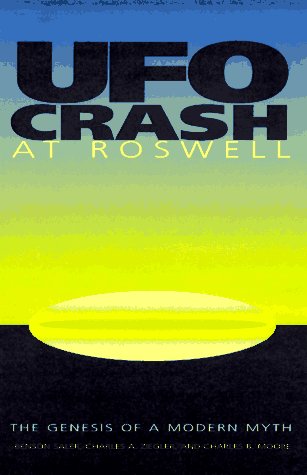An anthropological study of the alleged UFO crash in Roswell, New Mexico, treats the story as a modern myth that reflects popular beliefs in the omnipotence of technology, the duplicity of governments, and the existence of superior beings. UP.
It's not just skeptics who will relish this examination of the supposed crash of a UFO near Roswell, N. Mex., in 1947, and of the myth that has grown up around it. The crash and the alleged ensuing cover-up by the U.S. government has become a lynchpin among conspiracy theorists and those who believe in invading aliens. The three authors, all university professors, never deny the possibility that there was in fact a crash of an alien spacecraft, with alien victims (though they point toward the crash of a military balloon as a more likely explanation for the Roswell phenomenon). They argue, however, that the Roswell "technomyth" serves several functions as a "folk narrative," including the reinforcement of beliefs in omnipotent beings, and the channeling of anti-government sentiment. The myth, they say, is carefully and contentiously tended by a community of "ufologists" who act as "culture heroes" in attempting to liberate the truth from the government's clutches. One chapter further argues that the myth and community have many of the hallmarks of a religion. Despite its impeccable explanations about myths, however, the book's turgid prose will do little to dissuade the vast number Americans who believe that extraterrestrials have landed on Earth.
Copyright 1997 Cahners Business Information, Inc.
The UFO community strongly believes that the U.S. government has suppressed information about a supposed flying saucer crash near Roswell, New Mexico, in 1947. Here, a group of anthropologists look at the mythological aspects of the modern-day folk tale and show how accounts of "documented" events can evolve over time: a portion of the account remains accurate, while other parts get distorted, repressed, or expanded. They note that an event's mythological aspects are perpetrated by television docudramas and UFO authors. Cited among the latter group are Kevin D. Randle and Donald R. Schmitt (The Truth About the UFO Crash at Roswell, LJ 6/1/94) and Stanton T. Friedman (Top Secret Majic, LJ 10/1/96). Both groups reinforce conspiracy theories by using supposition and conjecture as fact. A detailed analysis of 1947 balloon flight experiments provides a possible basis for the myth. The book's academic tone, however, will appeal to a scholarly audience rather than UFO buffs. [In this anniversary year, see also Philip Corso's The Day After Roswell and Michael Hesemann and Phillip Mantle's Beyond Roswell, both LJ 7/97.?Ed.]?Gary D. Barber, SUNY at Fredonia Lib.
-?Gary D. Barber, SUNY at Fredonia Lib.Copyright 1997 Reed Business Information, Inc.
